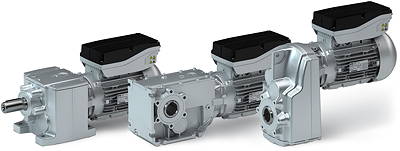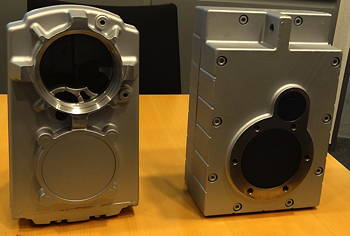The g500 boxes (shown below mounted on Lenze Smart Motors) are much smaller and lighter than the previous generation. For example, a 660Nm box, which previously weighed 40kg, now weighs 23kg – a 42% reduction – and occupies 6,050cm3, rather than 7,900cm3 – a 20% reduction.

Lenze expects the helical models to be the most popular, with the shaft-mounted helical versions offering a cost-effective mounting option with its hollow output shaft. The helical-bevel right-angle models have either a hollow or a male shaft and are available in ratios up to 100:1.
Lenze used powerful calculation and simulation methods, including finite element analysis, to design the compact gearboxes that have few corners and are easy to integrate into machines. The high efficiencies, combined with optimised airflows, mean that the gearboxes run cooler than usual. This, in turn, means that the seals wear less and have longer lives. Similarly, the lubricating oil lasts longer because it is operating about 10°C cooler than normal.
As an example of energy and cost savings that the new gearboxes could deliver, Frank Maier, Lenze’s board member responsible for innovation, cites the example of an automated high-bay storage and retrieval system with each stacker crane containing four or five gearboxes. With the new boxes, the weight saving could be around 60kg. This, combined with their high efficiencies, could save around 10,000kWh per crane per year, worth around €1,500.
Lenze sees the new gearboxes as an ideal companion for its integrated Smart Motor that it launched earlier this year. A patent-pending interface between the gearboxes and motors with a single seal allows them to be combined quickly using a simple screw movement. The threaded connection also results in shorter assembled lengths.

The Smart Motor’s speed can be adjusted on site from a smartphone app using wireless near-field communication (NFC) technology. One model can cover motor speeds from 500–2,600 rpm at a constant torque. Adding the new g500 gearboxes to the Smart Motor will allow a wide range of speeds and torques to be covered with just one type of geared motor.
The gearboxes can also be combined with Lenze’s IE2 MH three-phase AC motors, its inverter-optimised MF motors, and its MCA and MCS servomotors to create packages tailored to specific applications.
The new gearboxes will be coming onto the market in two phases: Lenze is starting with smaller versions in aluminium housings covering ratings from of 45–600Nm, before launching cast-iron gearboxes in ratings up to 13kNm in about a year’s time. Lenze will no longer supply low-efficiency worm gearboxes in the European and North American markets.
The company says that the new range of gearboxes proves that there is still potential for new developments in the field of electromechanics. “We went right back to the drawing board and asked ourselves some serious questions about everything we’ve achieved so far,” explains Rune Friis-Knutzen, the company’s head of strategic product and market development for electromechanical drives. “As the losses are so minimal, the motor has less energy to generate, which improves the bottom-line efficiency of the entire system. What’s more, the lower level of generated heat increases the overall service life.
“Intelligence is all about rethinking existing solutions to suit how they are used in actual applications, and bringing them to life them in a way that offers maximum benefit to mechanical engineers and plant operators,” he adds.

